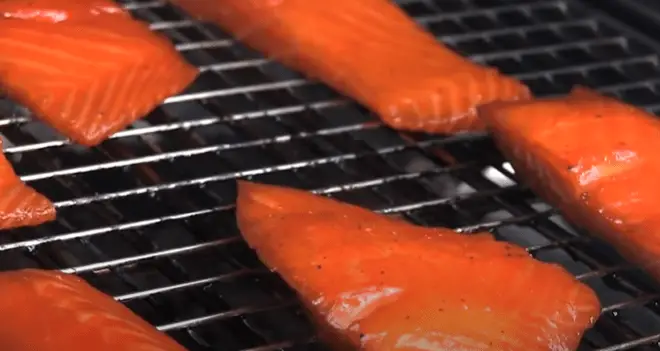Are you looking to improve your fish dishes?
Prepare for a smoke-filled culinary journey as we study the art of smoking fish.
I’ll be your dependable guide through the world of wood and flavors in this article.
I’ll reveal the best woods for giving your fish a delicious smokiness, from the delicate delicacy of apple wood to the strong strength of hickory.
So, whether you’re a seasoned smoking enthusiast or a curious novice, join me as we dive into the rich aromas, mouthwatering flavors, and irresistible allure of the best woods for smoking fish.
So, whether you are a seasoned smoker or an curious beginner, join me and explore the rich aromas, mouthwatering flavor and marvelous allure of the best woods for smoking fish.
Get ready to improve your seafood preparation abilities and master the art of smoking…!

- 6 Best wood for smoking Fish
- 1. Alder wood
- 2. Apple
- 3. Cherry
- 4. Maple
- 5. Hickory
- 6. Whiskey Barrel Chips.
- # What should I consider before purchasing wood for smoking fish?
- # Tips for Using Wood When Smoking fish.
- # Safety considerations When Smoking fish.
- # Which forms and sizes of wood work best for smoking fish?
- # What should be done to efficiently smoke fish?
- # Frequently Asked Questions
Recommended Reading:
– Best wood for smoking meat
– Top wood to smoke chicken
– Best Type of wood pellets for smoking
– Top wood for smoking beef
– Best wood choices for smoking pork
– Best wood for smoking brisket
– Best wood for smoked salmon
– How to Smoke Salmon in a Smoker
– Alder Wood for Smoking
– What are the best wood for smoking turkey
– Best wood chips for smoking
– Top wood for smoking lamb
6 Best wood for smoking Fish
1. Alder wood
- Delicate Flavor: Alder wood has a mild flavor that suits fish without dominating it and adds a light smokiness.
- Sweet Undertones: The alder wood imparts a sweet aroma to the fish, achieving an appealing balance of smoke and natural flavor.
- Light and Subtle Smoke: Alder wood produces a light, delicate smoke that preserves the delicate flavor and texture of the fish without overpowering it.
- Versatile Pairing: Due to its adaptability and mild flavor, alder wood pairs well with a range of fish, including trout, salmon, and whitefish.
- Moisture Retention: Alder wood provides exceptional moisture retention qualities that keep the fish moist and delicate while also adding a little smoky flavor to the food.
2. Apple
1. Fruity and Sweet Flavor: The fish acquires a fruity and sweet flavor from the apple wood, which also adds a delicious natural sweetness to the entire flavor.
2. Light and Mild Smoke: The apple wood produces a light and mild smoke that is ideal for fish because it brings out the delicate flavor of the fish without overpowering the other flavors.
3. Versatile Pairing: Apple wood is adaptable and goes great with different kinds of fish, such as salmon, trout, and halibut, enhancing their flavors and producing a lovely aroma.
4. Balanced and Delicate Smokiness: The subtle and well-balanced smokiness of apple wood highlights the fish’s natural features without overpowering them.
5. Lightly Scented Aroma: Apple wood has a lovely, mild fragrance. It improves the overall experience by giving the fish an alluring aroma.
3. Cherry
1. Subtle and Fruity Flavor: The fish acquires a mild, fruity flavor from the cherry wood, enhancing its original flavor. It gives the fish a slight sweetness without dominating its delicate flavors.
2. Mild Smoke: Cherry wood creates a gentle smoke, which makes it perfect for smoking fish. The mild smokiness gives the fish’s flavor more richness without being overbearing.
3. Versatile for Different Fish: Salmon, trout, catfish and other fish pair well with cherry wood since it is adaptable.. Because of its adaptability, it improves the flavor of several fish species and adds a nice aroma.
4. Beautiful Color: The fish acquires a beautiful reddish-brown color from the cherry wood, which enhances its overall appearance and presentation.
5. Aromatic Experience: Cherry wood produces a wonderful aroma when smoked, which makes for a pleasant sensory contact. The allure of the aroma of smoke adds to the enjoyment of smoking and enjoying the fish.
4. Maple
1. Sweet and Subtle Flavor: The sweet, mild flavor of maple wood creates the ideal balance of smokiness and natural flavors, enhancing the delicate flavor of fish without dominating it.
2. Light and Balanced Smoke: Maple wood gives it a delicate blend of smokey aroma and flavor.. It produces a balanced smoking experience that highlights the fish’s inherent qualities..
3. Versatile for Different Fish Types: Maple wood is a flexible option for smoking a variety of fish, from delicate white fish to robust trout or catfish. Its versatility enables experimentation in the kitchen and combination with various fish species.
4. Beautiful Color and Appearance: Maple wood adds the exterior of the fish a lovely golden-brown color by the, which improves its presentation and look.
5. Widely Available and Easy to Use: The variety of maple wood products, including chips, chunks, and pellets, ensures convenience for different smokers.
Try these different wood types for strong, varied flavors in your smoked fish:
For a bold and diverse range of flavors in your smoked fish, try these distinct wood types:
5. Hickory
1. Strong and Robust Flavor: Hickory wood imparts a strong and distinct smokey flavor to the fish, giving it a rich and savoury profile. Its strong flavor improves and combines with the fish’s natural flavors.
2. Versatility with Different Fish: Hickory wood pairs very well with fish that has a robust flavor. The strong smokey flavor makes these fish taste better, creating a wonderful and tasty dining experience.
3. Intensifies Natural Flavors: Hickory wood highlights and enhances the fish’s natural flavors, giving it a deep and nuanced flavor. Its powerful smokiness gives the richness and texture to the overall dish.
4. Reliable and Widely Available: For smoking fish, hickory wood is abundantly available and popular.
The consistent quality and mouth watering flavor make it a favorite for smoking enthusiasts..
5. Beautiful Smoked Color: The hickory wood imparts a beautiful golden-brown color to the smoked fish that enhances its appearance and makes it even more delicious..
6. Whiskey Barrel Chips.
- Unique Flavor: Whisky barrel chips provide a distinctive flavor experience with a smokey flavor and undertones of oak and whisky when used to smoke fish.
- Aromatic Qualities: With the aromatic flavor of oak, whiskey barrel chips give the fish a richer, more nuanced flavor.
- Versatility: The adaptable whisky barrel chips provide fragrance to a variety of seafood, including salmon, trout and halibut.
- Easy to Use: Whiskey barrel chips fit well in smokers and grills because they are small in size and burn quickly and release a consistent smoke.
- Sustainable and Recycled: Smoking fish with whisky barrel chips is a recycled and environmentally friendly solution..
# Comparison Table:
| Wood Type | Flavor Profile | Intensity | Recommended Fish |
| Alder | Mild, slightly sweet | Light | Delicate white fish, salmon |
| Apple | Fruity, sweet | Medium | Salmon, trout, white fish |
| Cherry | Fruity, subtly sweet | Medium | Salmon, trout, catfish |
| Maple | Sweet, subtle | Light | Delicate white fish, salmon |
| Hickory | Strong, robust | Strong | Salmon, tuna, swordfish |
| Cedar | Earthy, aromatic | Medium | Salmon, trout, shellfish |
| Whiskey Barrel Chips | Smoky, with hints of whiskey and oak | Medium | Salmon, trout, white fish, shellfish |
# What should I consider before purchasing wood for smoking fish?
- Fish Selection: Choose fresh and high-quality fish for smoking. Choose fish that are suitable for smoking, such as salmon, trout, mackerel, or whitefish.
- Fish Preparation: Before applying spices or marinade to the fish, select the fish, clean it properly and pat it dry.
- Seasoning and Marinades: You can use dry rubs, marinades, and brines to enhance the flavor of the fish. Fish should be allowed to marinate for a long time according to their type.
- Temperature Control: Maintain a consistent smoking temperature between 225–250°F (107–121°C) to avoid overcooking or undercooking the fish.
- Fish Placement: After arranging the fish on the smoker grate or using a fish basket, leave enough space between the pieces of fish to allow the smoke to circulate evenly.
- Smoke Control: You can use wood chips or chunks sparingly to enhance the flavor and avoid overpowering the delicate flavor of the fish.
- Cooking Time: Cooking time may vary depending on the thickness and type of fish. Therefore, use a meat thermometer to monitor the internal temperature of the fish and know the internal temperature.
- Monitoring and Adjustments: Check regularly. Make any necessary adjustments, such as adding wood chips and adjusting vents for airflow, to keep smoke and heat levels consistent.
- Safety Precautions: When handling and smoking fish, be cautious of safety and cleanliness. To prevent cross-contamination, keep all utensils, cutting boards, and surfaces clean.
- Experimentation and Practice: You will need to improve your fish smoking skills through experimentation with different wood flavors, spices or techniques to find your preferred method and flavor profile. So, don’t be afraid and keep trying.
# Tips for Using Wood When Smoking fish.
- Select the Right Wood: Avoid adding strong or heavy woods that may overpower the flavor of the fish and choose wood species such as alder, apple, cherry or maple that will enhance the delicate flavor of the fish.
- Soak Wood Chips: Using soaked wood is optional. Soak wood chips in water for 30 minutes before smoking to get moisture and flavorful smoke.
- Use a Smoker Box or Foil Packet: You can use foil packets and smoker boxes with wood chips when smoking fish.
- Control the Temperature: It is very important to maintain the temperature while smoking fish. You have to keep the temperature constant between 225-250°F (107-121°C) throughout the entire smoking process.
- Avoid Excessive Smoke: Heavy smoke is not suitable for fish. Monitor smoke level.
- Consider Adding Aromatics: You can add herbs, spices, and citrus slices to enhance the taste of fish.
- Rest and Serve: Allow smoked fish to rest before serving to enhance flavor and juiciness.
# Safety considerations When Smoking fish.
Here are five important safety considerations when smoking fish:
- Cleanliness: Before and after handling fish, wash your hands properly with soap and water. Keep all surfaces, cutting boards, and utensils clean to prevent cross-contamination.
- Storage and Temperature: Keep fish refrigerated or at temperatures below 40°F (4°C) until ready to smoke.
- Safe Internal Temperature: Cook fish to a minimum internal temperature of 145°F (63°C) using a meat thermometer. Measure the temperature in the thickest part of the fish.
- Avoiding Cross-Contamination: Keep raw fish separate from other foods and use separate utensils for fish. This helps avoid transfer of bacteria and ensures food safety.
- Proper Smoking Equipment: Use a well-maintained outdoor smoker in a space with good ventilation.
# Which forms and sizes of wood work best for smoking fish?
When it comes to smoking fish, there are several wood forms and sizes that can be used. Here are some popular options:
1. Wood Chips: Small wood chips are a popular choice for smoking fish because they ignite quickly, producing a mild smoke flavor and moisture.
2. Wood Chunks: You can use wood chunks to smoke longer. As these pieces release smoke slowly and add rich flavor to the fish. Plus it works well with both hot and cold smoking.
3. Wood Pellets: In pellet smokers, using wood pellets is convenient and simple. When smoking fish, they offer different flavors because they produce steady smoke and are available in a range of flavors.
4. Wood Planks: A popular method is to grill fish on wooden planks such as cedar or alder that impart a unique smoky flavor and help retain moisture..
# What should be done to efficiently smoke fish?

To smoke fish effectively, follow these steps:
- Choose the right fish: Pick fresh fish with firm meat, like mackerel, trout, or salmon. Make sure the fish is scaled and cleaned appropriately.
- Brine the fish (optional): To improve the fish’s flavor and moisture, brine it. Prepare the brine by filling a bowl with water and ingredients to taste. Dip the fish in that solution for 30 minutes.
For dry brine- Pat the fish dry and sprinkle with salt, pepper, and any herbs or spices of your choice.
- Prepare the smoker: Make sure your smoker is clean and in working condition. Set smoker to preheat (180-200°F (82-93°C).
- Choose the wood: Select the right wood for smoking fish. Alder, apple, cherry, and maple are a few of the preferred choices.
You can add wood chips or chunks with a box in the smoker to generate flavorful smoke.
- Smoke the fish: Place the fish on the grill of the smoker, leaving enough space between each piece of fish for good smoke circulation. Close the lid. Smoke the fish for the necessary amount of time, often 1-4 hours, depending on the thickness of the fish and the desired level of smoky flavor.
- Monitor the temperature: Use a meat thermometer to monitor the temperature. The internal temperature should be reached 145°F (63°C) for thorough cooking.
7. Rest and serve: Allow smoked fish to rest slightly before serving to ensure that the juices circulate evenly after reaching the proper internal temperature.
# Frequently Asked Questions
# What kinds of wood are ideal for smoking fish?
Some common woods used to smoke fish include alder, apple, cherry, maple, and hickory.
# Can I smoke fish using hardwoods like oak or mesquite?
You should not use Hardwoods. Since it can be overpowering for fish, it’s best to stick to milder woods.
# Can I use soaked wood chips for smoking fish?
Yes. It is not necessary to smoke your fish using soaked chips. It is completely up to you.
# Can I combine different types of wood while smoking fish?
Yes, you can mix different types of wood for smoking fish.
# Which woods should you stay away from when fishing?
Avoid using woods with resin, such as cedar or pine, as they might impart unpleasant tastes to fish.
# Can I use wood pellets for smoking fish?
Yes, you can use wood pellets to smoke fish. You should have a pellet smoker..
# Is it necessary to peel fish before smoking it?
It is not usually necessary to skin the fish before smoking it. Mostly, in smoking methods the skin remains on the fish during the smoking process. The skin enhances flavor, keeps the fish from sticking to the grates or racks during smoking..
# What safety steps should be taken when smoking fish with wood??
- Clean properly.
- Use oak, hickory, apple, cherry, and alder to smoke fish.
- Maintain proper ventilation.
- Use a dedicated smoker.
- Prevent cross-contamination.
- Follow temperature safe ranges between 160°F to 250°F or 70°C to 120°C.
- After marinating the fish, keep it in the fridge to stop the growth of bacteria.
- Avoid overcooking.
- Keep a fire extinguisher nearby you.
# In what way does the choice of wood impact the flavor of smoked fish?
The choice of wood for smoking fish can significantly impact the flavor, with different woods imparting distinct flavors ranging from delicate and sweet to rich and robust.
# Can I use fruit woods for smoking fish?
Yes, you can use fruitwoods like apple and cherry for smoking fish to add a subtle sweetness and fruity aroma.
# What is the difference between alder, hickory, and maple for smoking fish?
Alder wood provides a mild and slightly sweet flavor, hickory offers a stronger and bold taste, while maple gives a delicate and slightly sweet smoke.
# Can I mix charcoal and wood for smoking fish?
Yes, you can combine charcoal and wood to create a good balance of heat and smoke, enhancing the flavor of the fish.
# Conclusion
In conclusion, the type of wood used for smoking fish plays a critical role in achieving the desired flavor and texture.
Alder, apple, cherry, hickory, and maple are some of the best woods for smoking fish due to their unique flavors and characteristics.
It is essential to use the right size and form of wood for smoking fish, whether it is chunks, chips, or pellets.
Remember to follow safety considerations and use the tips and techniques outlined in this article for a successful smoking experience.

